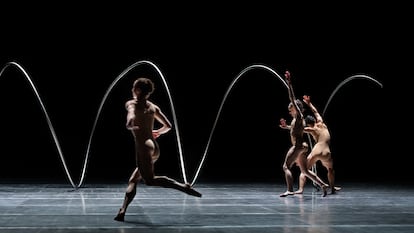Saburo Teshigawara (Tokyo, 70 years old) is a self-guarding angel. Small and strong as a Shinto reed, this artist, today already a consecrated, mature figure with an exemplary career, has inserted himself into the representative tradition of Western contemporary dance without fanfare and approaching the work from his style, a formulation that combines of cerebral distillation with a certain ceremonial framework aesthetic. That kind of distant rite that he provokes is a way of placing ourselves in a cardinal point of the work, wrapping ourselves in the golden and virtual fabric of physical poetry, assimilating it and making its enjoyment a lyrical experience. Transformation, scheduled this weekend at the Teatros del Canal in Madrid, in a production by the Basel Ballet, it is a great work of synthesis and recapitulations; Teshigawara plans an abyssal journey with no other purpose than to give an opportunity to those who want to say who they were, what they did, what they fought against.
Once in this same newspaper he was described like this: “Small and ageless; “He has that oblong, shaved cranial morphology of all the greats of Japanese dance, from Kazuo Oono to Ushio Amagatsu.” This has been accentuated and when you see him walk you cannot be sure if he touches the ground: it is like his art, levitating. Wayne McGregor told the very young dancers of the College of the Venetian Biennial in 2022: “Listen to him, please. Pay attention to everything he suggests.” The way of being a wise man in a quiet voice, seeking an epiphany by contrast is once again the trend, and we find a lot of Elizabethan theatrical tradition, only in reverse: the “white act” and ghostly first, and the second, if you will. realistic, where a redemption is sought with naturalistic, extreme and morally inclined characters.
Translating a determined artistic personality into a style of danced expression is an initially chimerical and very difficult undertaking. Teshigawara knows this and achieves it with that convincing method, elegant in itself, of whispering and reasoning while advancing to obtain the material for the show, the fixation of its reading, which we will see already regulated.
Mounting his choreographies at the Paris Opera, the Venice Biennale or the Basel Ballet, Teshigawara is pleasantly accepted, his obtained beauty penetrates, and is authentic; That glorious universality is achieved with and on two basic ingredients: honesty and awareness of resources. Today, when so many idiots are saying that ballet is not necessary and that it is obsolete, let us remember for the forgetful and ignorant that Saburo Teshigawara began his training—and continued it for years—with academic ballet, and that when he formed the KARAS cell in 1985 with Kei Miyata, reworked a line of experimentation on that canonical training. In Basel, by the way, and so that we are not fooled, morning ballet class is mandatory.
For Teshigawara, the global richness of the scenic work passes through its scenographic packaging (extracted, in his case, from experience in the Plastic or Visual Arts) where the selected poetic canon also exercises its dominance. transformation has two acts and two worlds: one conceptual (Like a Human) in plethoric abstractions of the ensemble, and a second, metamorphosis, anchored in everyday life and in the dispersion of individuals (or individualities). First we see the souls exposed, then the mortal bodies.
The first part: Like a Human, for 12 dancers, uses equidistances and a geometry based on verticality, although the work opens with some body phrases that sound like fleeting butoh dance quotes extracted from the Buyo base: the ancestral belies any mystification. There is sculptural cleanliness and delicate geometry.
The second part, Metamorphosis, for 17 artists, takes us on board with this Charon until we reach a long, post-baroque ending, bounded like a bizarre one where for the last time Teshigawara takes us by the hand, taking us to an inevitable and dark limbo, a place, perhaps, where we can ask Prospero : Are we lost again or are we already dead? The sharp, exquisite and very accurate musical selection helps to untie this concerting knot. Teshigawara leaves our hearts like a raisin, but we must thank him. Back to The Tempest (which today is believed more than ever to be Shakespeare’s last creation), Ángel-Luis Pujante warns us that “it is a drama of lost illusions”; transformation (which can be roughly translated as “transmutation” or “transubstantiation”) in his own way, too.
The group of artists from Basel, whose acting intelligence and choreographic expertise are immediately understood by just seeing them (the intellectual level of the dancers, sometimes unfairly, is questioned), manages to fully convey the choreographer’s intentions. In the work we see four capable Spanish artists: Javier Ara Sauco, Marina Sánchez Garrigós, Tana Rosas Suñé and Andrea Tortosa Vidal, and the repeater, the true architect of the maintenance of such a complex scenario, is a Madrid native: Fernando Carrión.
Verwandlung. Basel Ballet. Artistic director: Adolphe Binder
Choreography, set design, lights (with Sergio Pessanha), costumes: Saburo Teshigawara; choreographic collaboration: Rihoko Sato; original music: Tim Wright and S. Teshigawara; songs: O. Messiaen, M. Ravel, WA Mozart, S. Rajmaninov, A. Corelli, T. Albinoni, C. Franck and Pavel Chesnokov. Choral director: Michael Clak; assistants: Ján Špoták, Maria Chiara Mezzadri, Javier Ara Sauco.
Red Room. Canal Theatres, Madrid. June 22nd.
Subscribe to continue reading
Read without limits
_

